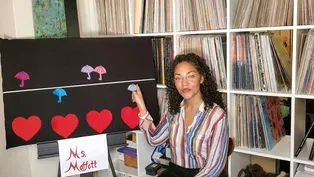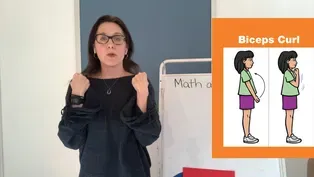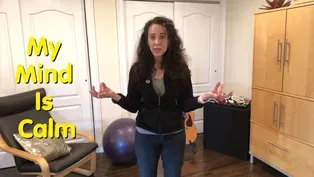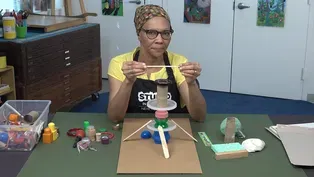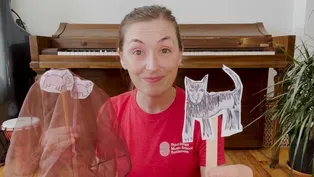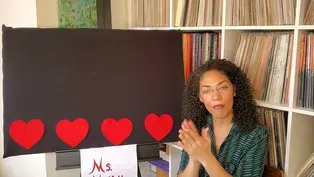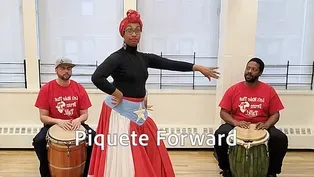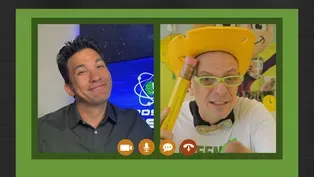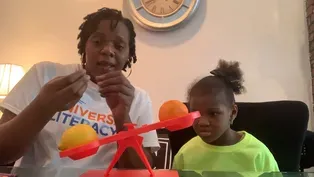
Can You Hear the Short “u” in Sunny?
2/4/2021 | 58m 13sVideo has Closed Captions
Learn to keep track of the weather, play domino parking lot, read LEO THE LATE BLOOMER.
Keep track of the weather, play domino parking lot, read LEO THE LATE BLOOMER, blend and decode short u, w, j, y, and v. LET’S LEARN helps children ages 3-8 with at-home learning. One-hour programs feature instruction by educators and virtual field trips.
Problems with Closed Captions? Closed Captioning Feedback
Problems with Closed Captions? Closed Captioning Feedback
Let's Learn is a local public television program presented by THIRTEEN PBS

Can You Hear the Short “u” in Sunny?
2/4/2021 | 58m 13sVideo has Closed Captions
Keep track of the weather, play domino parking lot, read LEO THE LATE BLOOMER, blend and decode short u, w, j, y, and v. LET’S LEARN helps children ages 3-8 with at-home learning. One-hour programs feature instruction by educators and virtual field trips.
Problems with Closed Captions? Closed Captioning Feedback
How to Watch Let's Learn
Let's Learn is available to stream on pbs.org and the free PBS App, available on iPhone, Apple TV, Android TV, Android smartphones, Amazon Fire TV, Amazon Fire Tablet, Roku, Samsung Smart TV, and Vizio.
Providing Support for PBS.org
Learn Moreabout PBS online sponsorshipMore from This Collection
Video has Closed Captions
Read SCHOOL BUS and draw one, learn about prefixes and pitch, build sculptures. (57m 48s)
Running and Counting Both End in “ing”!
Video has Closed Captions
Move to improve, find the missing number, learn songs from Ghana, read ABUELITA’S SECRET. (58m 17s)
What Sound Does “aw” Make in Draw?
Video has Closed Captions
Read a story, discover "au" and "aw," learn about density, count, and move with music. (56m 58s)
Can You Find the Short “u” in Subtract?
Video has Closed Captions
Help Super Grover 2.0 solve a prickly problem, read ALL THE WAYS TO BE SMART. (56m 19s)
What Sound Does “gl” Make in Glove?
Video has Closed Captions
Play the glockenspiel, help Super Grover 2.0 make a cart move, read TWO WOOL GLOVES. (58m 9s)
Incredible Starts with Short “i”!
Video has Closed Captions
Solve problems with Super Grover 2.0, catch a rainbow, hear a piano sound like a cuckoo. (56m 9s)
What’s the Sound of “oo” in Book?
Video has Closed Captions
Explore animals’ form and function, sing about the 3 little pigs, read THE LITTLE BOX. (58m 15s)
We’re Reducing, Reusing and Recycling!
Video has Closed Captions
Learn all about rhythm and the number 9, read A BAG IN THE WIND. (56m 17s)
Video has Closed Captions
Learn to dance bomba and grow food in a city, read WOLF CUB’S SONG. (55m 20s)
How Many Syllables are in Invent?
Video has Closed Captions
Invent your own instrument, make 10 to add numbers to 20, read ONE GOLDEN RULE AT SCHOOL. (57m 36s)
Video has Closed Captions
Learn about the science behind mind reading, count shells, read MY BIG FAMILY. (57m 27s)
Which is Heavier: One Apple or Two Apples?
Video has Closed Captions
Defy gravity, learn secret code words for fast and slow in music, read WHOOO KNEW? (58m 5s)
Providing Support for PBS.org
Learn Moreabout PBS online sponsorship[upbeat music] - [Narrator] Ready to learn?
- Hi.
- Hi.
- [Narrator] It's time to share a story, read and write.
- Let's read it back.
- [Narrator] Discover science, sing.
♪ Some ♪ Play and so much more.
- Cupcake.
- Very good.
- [Narrator] Stay tuned for lessons and activities.
- We're gonna start making some words, isn't that fun?
[upbeat music] - [Narrator] Funding for this program was provided by the JPB Foundation.
[upbeat music] - Hi scholars, how are you doing?
My name is Katherine Rodriguez and I'm here today to read to you this wonderful story.
Have you seen this story before?
Some of you might've.
So this story is called, Leo the Late Bloomer.
And this story is written by Robert Kraus and pictures are by Jose Aruego.
So I'm so excited to sharing this story with you today and after the story we're going to do an activity.
So here's my flower.
You'll see why I chose to do a flower for this activity.
But for right now, let's focus on this story and dive in.
Leo the Late Bloomer.
Hmm, I think that this might be Leo over here, let's see.
Leo the Late Bloomer.
Leo couldn't do anything right.
Oh, no.
Look at Leo.
I wonder how Leo is feeling.
Oh, yes, you're right.
He does look a bit upset.
He looks like he's stuck as well.
He couldn't read.
Oh no, I'm looking at how Leo is feeling and, you know, I felt that way before it does get a little bit frustrating when we have a challenge or when something doesn't come so easily to us.
He couldn't write.
So here we have our friend, the owl and he is writing in script, owl.
The elephant is writing in script, his name, elephant and the snake is writing in script the word snake.
Here we have the plover writing his name, the crocodile writing his name in script as well.
And then over here we have Leo.
It's a little difficult to see what he's writing but he's definitely writing something, you can see that.
Although he seems a little bit discouraged, he couldn't draw.
He was a sloppy eater.
Sometimes eating can be hard, it's okay to get sloppy.
Leo doesn't feel so good about that and he never said a word.
So let's turn the book over.
When we turn the book over, we can see different words that different animals are saying, for example we see that the owl is saying hoot the elephant is going, thrump, the snake is going, hiss, we have the plover going, pip and the crocodile going, crunch, crunch but, Leo isn't saying anything and we see that Leo is not feeling so good about it.
He probably wants to speak up, but he's having a little bit of difficulty.
"What's the matter with Leo?"
Asked Leo's father.
"Nothing," said Leo's mother.
"Leo is just a late bloomer."
Here, we have that word again, late bloomer, better late than never thought Leo's father.
Every day Leo's father watched him for signs of blooming.
And every night Leo's father watched him for signs of blooming.
"Are you sure Leo's a bloomer?"
Asks Leo father.
"Patience," said Leo's mother a watched bloomer doesn't bloom.
So Leo's father watched television instead of Leo, the snows came Leo's father wasn't watching but Leo still wasn't blooming.
And here we have Leo playing around, chasing the bunny while his friends are all making snow animals of themselves.
We see the snake making a snow animal himself, we see the owl also making a snow animal of himself and the plover, the alligator or the crocodile I should say and the elephant.
So they're all making these snow animals of themselves and Leo's just chasing around that bunny.
The trees budded Leo's father wasn't watching but Leo still wasn't blooming.
So here we see the buds, the buds are those when plants start to bloom, a little buds come out.
So you get to see the buds are starting to blossom and come out from the plants.
And you know, over here we have all his friends and they're playing with the buds then Leo's just chasing around that bunny.
Then one day in his own good time, Leo bloomed.
So there we have that word again, bloomed.
Let's see, how did he, how did he bloom?
He could read, he could write, he could draw, he ate neatly and look Leo's face has changed he's a little bit happier, he's getting proud of himself.
He also spoke and it wasn't just a word it was a whole sentence and that sentence was, "I made it."
Wow.
How do you think the family's feeling?
How do you think Leo is feeling, most importantly?
You're right, his family they're feeling proud of him.
Wow, Leo you did it your writing, your spelling, your reading, your eating, you really did make it.
And Leo himself is feeling all so proud of himself.
So friends that word, bloom that word came up a lot in our reading, the word bloom and what it means to bloom.
So Leo at the beginning was still a little seedling lets say and he was still in his little seed it took him some time, some practice.
It took him effort to be able to slowly break out of that little seed and to start growing and blooming and he did bloom.
We saw a lot of change in Leo.
He went from not being able to read or write not being able to even say a word to slowly say a phrase an actual sentence and to even reading and writing.
So we call that blooming and we call that change over time as well and that is what happened with Leo.
So now I want you to think to yourself there are some things that we can do and there's also some things that we're still working on and that's perfectly fine.
For example, I'm always working on becoming a stronger reader, especially as I begin to read more and bigger books I want to always try to see what kind of words are in those bigger texts and understand them.
So if you're working on that right now, keep on going because you never know what level you can reach and how far you can go on reading.
You have to keep on trying.
So for today's activity, I made a flower because you could see that there was a theme about blooming, about flowers and growing.
So I made a flower and you can do this on a piece of paper, on a whiteboard if you have at home, you can use your marker, crayons, pencils, anything you have at home.
And what I want you to do is just make a very simple flower.
You're gonna make a little oval and inside of the oval you gonna right, I can.
And then you're gonna draw petals that also look kind of like round as well surrounding that oval.
So these petals, you can make them in a different color or the same color.
You have a stem and a little leaf so that it really looks like a flower that's bloomed.
And I want you to think about all the ways that you have bloomed and what you can do.
So for example, I can read, I'm gonna write here, I can read non fiction books.
So that is what I am going to write on my petal, I can read nonfiction books.
I love books about science and about outer space and those are books that I enjoy reading.
So I write, I wrote down I can read non-fiction books.
Now think to yourself, what can you do?
And be proud of it, no matter how small you think it is it's actually not small, it's a really big deal.
You thought about it, great.
Now it's your turn.
So do the next petal and write down what you can do.
I can and tell me what you can do.
I'm so excited to see how beautiful your flowers turn out and how creative.
Maybe you're gonna find that you have even more petals than in the mine.
I'm gonna give you another example because reading isn't the only thing we can do.
I can draw a picture of me, I can draw a picture of me.
I get so excited, whenever I can draw a picture of myself.
You want to take a look?
I have a very simple picture of myself, but guess what?
I am so proud of it.
And this is a picture of me.
So fill in the rest of your flower.
I'm so excited to see your beautiful creations enjoy and take care.
- Hi, movers and shakers this is violet and it's time to get a little bit silly.
Are you ready for a song?
For this one, you're just gonna need to put your fingers up.
So let's wiggle our fingers, wiggle our bodies and get ready.
♪ There were five in the bed ♪ ♪ And the little one said ♪ ♪ Roll over ♪ ♪ Roll over ♪ ♪ So they all rolled over ♪ ♪ And one fell out ♪ ♪ There were four in the bed ♪ ♪ And the little one said ♪ ♪ Roll over ♪ ♪ Roll over ♪ ♪ So they all rolled over ♪ ♪ And one fell out ♪ ♪ There was three in the bed ♪ ♪ And the little said ♪ ♪ Roll over ♪ ♪ Roll over ♪ ♪ So they all have the rolled over ♪ ♪ And one fell out ♪ How many are left?
One, two.
♪ There were two in the bed ♪ ♪ And the little one said ♪ ♪ Roll over ♪ ♪ Roll over ♪ ♪ So they all rolled over ♪ ♪ And one fell out ♪ How many are left ?
♪ There's one in the bed ♪ ♪ And the little one said ♪ ♪ Ah, all this for me ♪ Have a good day.
[upbeat music] Hi friends, I'm Miss Lauren and today we are going to continue learning about letters and sounds.
We're going to start by reviewing some consonant letters of W, J, Y and V. We are also going to be learning a new vowel today the letter U and it's short sound and then we're going to play a word sort game, all right.
So we have lots of good things to do today and you know what?
You don't necessarily need any materials I just need you to be super good listeners and just keep up with me as best you can, all right.
All right, so let's get going.
Okay, readers.
So let's start by reviewing some consonant sounds, okay.
I'm going to say a word and I would like for you to tell me the beginning sound, great.
I'll do one for you.
Listen, the word is jump.
The beginning sound is J, so you would say jump, J.
Got it, okay.
The word is when you say?
Right.
When, W, did you say that?
Good job.
Next word, vase you say?
Yeah, did you say vase, V?
Good job, it's beginning sound was V. Next word, was you say?
Was, W, good job.
Next word, just you say?
Just, J, yeah.
Next word, vacuum you say?
Vacuum, V, good job.
Ready?
Yellow, you say?
Yellow, Y, yeah.
Ready?
Yes.
Next word, yes you say?
Yes, Y, great job.
Okay readers, let's take a look at the letters that we'll be using during our lesson today.
Before we begin our activities.
As a reminder, the vowels are A, E, I, O, U and each one stands for many sounds.
Today, we will be focusing on one.
This is the letter U, U, umbrella, u, okay.
The umbrella has a short U sound and the letter U can stand for the short U sound when it's at the beginning or in the middle of a word.
I'm gonna put that over here, okay.
Let's go ahead and take a look at this word this is the word up, up, up.
When there is one vowel and it's followed by a consonant the vowel usually stands for it's short sound.
In this case, it stands for u.
Let's take a look at other consonant letters that we will be focusing on for today.
This is the letter W, W, watch, w. Let's write the word web, are you ready?
Web, W, eb, web the w sound can be written with a W. Let's go ahead and take a look at the next consonant.
This consonant is the letter, J. J, jacket, j.
Let's write the word, Jug.
Ready?
J-U-G, jug.
The J sound can be written using the letter J, okay.
Let's go to our next letter.
Next letter is Y, Y, yoyo, y, y.
Okay, let's practice by writing the word, yak.
Ready?
Yak.
Y-A-K, right.
So the y sound can be written using the letter Y.
And our last consonant is this, this is the letter V, V, van, v. We'll put that right here.
Let's practice by writing the word, vat.
Vat.
V-A-T, vat, so this sound v can be written with using the letter V. Okay, now let's practice using these letters by reading some words together are you ready?
Let me flip my board around, let me see if you can see it correctly, I think that's good.
So we have our letters here and I'm gonna go ahead and I'm going to get some letters ready for us.
I'm gonna push the rest down, okay.
So here is our word, I'm gonna make it nice and high for everyone to see, okay.
So let's see, this is the word.
Hmm, well, what is this word?
Let's take a look, let's sound it out, ready?
Y-U-M, right, let's put it together.
YU-M, let's put it all together.
Yum, huh, yum.
Yeah, that's our word.
All right, are you ready for another one?
Let's try, let's do this one, ready, ready?
J-U-T, push this together ju, Jut, huh, did you get jut?
Good job.
All right, let's mix it up a little bit even more.
Are you ready?
Okay, let's do this one.
V-A-N, va, van, van.
Yeah, did you get van?
Good job.
All right, let's try this one.
Wow, let's see.
Okay, ready?
W- A- G, put it together, wa, put this together, wag, wag.
Did you get that too?
Wonderful.
All right, friends you did a good job.
Let's keep going, let's see if you can read these words on your own.
Are you ready?
I'm gonna write them down so as I write them, you can sound them out.
You ready?
Okay.
Do we know what that is?
Go ahead, J-U-G, right.
Jug, jug, jug, good job.
All right, now let's see if you got this one.
I'll do this one with you again are you ready?
Wi-g, wig, yes, you're right.
Let's do this one, you try.
Yam, did you get yam?
Okay, are you ready?
Here we go.
Tub, did you get tub?
Yes.
Ready?
Yip, yeah.
And let's do this one.
Ready?
I move my board a little, ready?
H-U-T, hut.
Yes, wonderful.
So all together we have had jug, wig, yam, tub, Yip and hut.
Excellent, I think we're warmed up.
I think you know these consonants and the short vowel U sounds and I think we're ready to begin our lessons.
Okay readers so now we're going to do our word sort, we're going to use two main words to help us out.
The first one is nut, N-U-T, U, U we're gonna pay attention to the vowel sounds.
This is the word nut and then we're also gonna use this as a heading, right.
Our other word is going to be not, can you say that?
Not, O, O that's the middle sound.
So let's take a look.
Let's do the word hop, let's listen carefully for the middle vowel sound.
Is it going to fall under nut?
Well, let's see.
Nut, hop.
Does that have the same sound?
U, O, let's try this one.
Not, hop, yeah, do you hear it?
It does, it has that same o sound or the short O sound.
All right, let's do this one.
This is the word tub, you say tub, u, u.
Let's see nut, tub, u, u I think so but just to make sure not, tub o, u, can't be, can't be has to go on that side.
All right, here's another one, hot, you say, hot, o, o.
We're getting better at this now, let's see nut, hot, u, o.
Not, hot, absolutely definitely on that side.
Let's do another one.
Ready, bug.
You say bug, u, u.
Do you agree?
Let's see, nut, bug, u, u. Yeah, it does have that same short U sound you should be getting better as we go.
Here's another word, ready?
Here's the word, mud.
You say, mud, u, u. Hmm, is that gonna be here?
Nut, mud, u, u has the same vowel sound.
Not, mud, o, u.
We know it goes there, we know it by now.
You ready?
We have one more word, hug.
You say, hug.
Yeah, H-U-G, u, u that's the middle sound.
Let's see, do you, do you agree?
Nuts, hug, u, u, definitely, it goes there.
Good job, sorting the words with me.
Readers, you did an excellent job today.
We reviewed consonants W, J, Y and V, we focused on the short lead, short U sound for the letter U and we also did a word sort so we can really hone in to the sounds of u which is our short U and o which was a review of short O. I hope you enjoyed our lesson today and please come back and tune in so you can continue learning about your letters and sounds, bye.
[upbeat music] - Hello friends, my name is Miss Glenda and today we're going to practice working with our numbers.
But before we begin we should always say hello to our friends.
So let's begin.
♪ Hello ♪ ♪ Hello ♪ ♪ I see you ♪ ♪ Hello ♪ ♪ Hello ♪ ♪ Hello ♪ ♪ I see you out there ♪ ♪ Hello ♪ ♪ It's time to play and learn ♪ ♪ Let's say hello ♪ ♪ Hello ♪ ♪ It's a brand new day ♪ ♪ Hey ♪ ♪ Hey ♪ ♪ Let's say hello ♪ ♪ Hello ♪ ♪ Be sure to wave ♪ ♪ Wave ♪ ♪ Wave ♪ ♪ When you say hello ♪ ♪ Hello ♪ ♪ Hello ♪ ♪ Hello ♪ ♪ I see you ♪ ♪ Hello ♪ Okay, boys and girls and friends today we are going to play the domino parking lot game.
And so in order to play the domino parking lot game we need our dominoes and we have a parking lot.
You will see that our parking lot is numbered zero, one, two, three, four, five, six, seven, eight, nine, 10, 11, 12.
So to play the parking lot game what we're going to do is we're going to count up the numbers that we have on our dominoes and then we're going to find the correct spot.
So let's practice together, on this domino we have one, two, three, once again on this domino, how many do we have?
Let's do it together, one, two, three dots.
So let's start driving into our parking lot when I start, we're gonna say we're gonna get ready to move.
Okay, are we ready?
Tell me when to stop.
We're going to - [All] Go, go, go, go, go, go, go, go, go go, go, go, stop.
- Stop, okay.
Should we turn left or should we turn right?
Where do we see the number three?
- [Female] Left.
- That's correct, let's turn left.
And for the next number, wow, there are a lot of dots on this card.
Let's count the dots together.
Okay, boys and girls and friends.
One, two, three, four, five, six, seven, eight, nine.
Let's count again to make sure.
One, two, three, four, five, six, seven, eight, nine.
We have nine dots on this domino.
It is time to start driving into the parking lot.
It's time to go, go, go, go, go, go, go, go, go, go, go, go, go stop.
Are we gonna fit in the parking lot I think we might have to back up a little bit.
Okay, good job.
So we are looking for the number nine do we go left or we go right?
Where do we see the number nine?
Lets think about it.
- [Female] Right - That is correct, we turn into the right and what number do we see here?
Nine, so let's put down our domino in the parking lot.
So number nine is here, great job.
Now lets find next domino, let's count the dots.
One, two, three, four, five, six.
Let's go find our parking spot.
It's time to go- - [Female] Go, go, go, go, go, stop.
- Yes, cause we are looking for the number six and the number six is, is it to the right?
I'm sorry, is it to the left or to the right?
Let's think about it.
- [Female] Right.
- Yes, we are going to the right lets move down our domino make sure our domino stay safe in the parking spot, correct.
Let's take our next card, let's look at our card let's count together.
How many dots do we see?
Let's count one, two.
Let's do it again, one, two.
We see two dots on the domino.
Okay, it's time to find the proper parking spot.
So it's time to - [All] Go, go, go, go, go, go, go, stop.
Do we turn left or right?
We are looking for the number two.
Where do you see the number two friends?
- [Female] Left.
- That is correct, we are going to the left.
So let's make sure that our domino is safe in the parking spot.
All right, great job friends.
Let's count together one, two, three, four, five, six, seven, eight, nine, 10, 11.
Wow, that's a lot of dots.
So we have 11 dots let's find the parking spot.
It's time to - [All] Go, go, go, go, go, go, go, go go, go- - We're looking for the number 11.
- [All] Go, go, go, go, go, stop.
- Okay, are we gonna turn left or are we gonna right?
Let's think about it, where do we see the number 11?
- [Female] Right.
- Yes, we're gonna turn right and go into a number 11 parking spot.
So let's put on our glue to make sure that it is safe, okay.
Next domino, how many dots do we see here?
One, two, three, four, we have four dots on this domino.
So now what spot are we looking for?
Let's look for the number four, let's see where this domino was going to park.
It's time to - [All] Go, go, go, go, go, go, go, go, go, go, go, go, stop.
- Are we going to turn left are we gonna to turn right?
Let's think about it, where is the number four?
- [Female] Left.
- Yes, that's correct we're going to turn left.
So let's put our glue, put our glue and put our domino, all right.
We're doing a great job friends.
How many dots do we see on this domino?
Let's count, one All right, let's look at our parking lot let's see if we can find the number one, okay.
Let's start driving into the parking lot.
It's time to - [All] Go, go, go, go, go, go, go, stop.
- Do we turn left or do we turn right?
We are looking for the number one.
- [Female] Left.
- That is correct.
We are turning left and let's put our glue down so that our domino is secure in its spot.
Next number, let's count our dots.
One, two, three, four, five, six, seven we have seven dots all together.
It's time to start domino driving down the parking lot.
Let's go find the number seven.
It's time to - [All] Go, go, go, go, go, go.
- [Female] Stop.
- Stop, are we going to turn left or right?
We are looking for the number seven - [Female] Right.
- We are turning right, so that is correct.
So let's glue down make sure our domino is safe in its spot.
All right, we're almost done with our domino parking.
Let's keep going friends, let's count up the dots.
One, two, three, four, five, six, seven, eight.
We have eight dots all together.
So it's time to - [All] Go, go, go, go, go, go, go go, go, stop.
- We're looking for the number eight, will we turn left or right?
Let's think about it.
- [Female] Right.
- That is correct, we're turning right.
Okay, next domino up.
Let's count the dots, one, two, three, four, five.
We're gonna look for the number five on the board and when we're ready, it's going to be time to, - [All] Go, go, go, go, go, go, go, go, go, go, go, go, go, stop.
- We are looking for the number five, do we turn left or do we turn right?
- [Female] Left.
- That is correct, let's secure the number five in its spot.
All right, great job friends.
Oh, how many dots do we see here?
I don't see any dots, do you guys see dots?
I don't see anything, we say that there are zero dots.
Lets try to find the number zero.
Okay, it's time to, - [All] Go, go, go, go, stop.
- We're looking for the numbers zero, do we turn left or do we turn right?
- [Female] Left.
- That is correct, we do turn left, got it right.
Now for our next domino.
Oh wow, there are a lot of dots on this domino so let's count one, two, three, four, five, six, seven, eight, nine, 10, 11, 12, 12 dots all together.
So let's to find the number 12 on our parking lot board.
Let's get ready, cause it's time to - [All] Go, go, go, go, go, go, go- - We're looking for the number 12.
- [All] Go, go, go, go, go, go, go, go, go, stop.
- Do we turn left or do we turn right?
- [Female] Right.
- That is correct, so let's secure the number 12 there, let's put the number 12 in the right's space, great.
All right, one more domino left.
Let's count the dots all together, One, two, three, four, five, six, seven, eight, nine, 10.
We have 10 dots all together.
Let's find number 10 on our parking lot map.
Okay, let's get ready to drive.
It's time to - [All] Go, go, go, go, go, go, go, go, go, go, go stop.
- Do we turn left or do we turn right?
We're looking for the number 10.
- [Female] Right.
- That is correct, we turn right into the parking spot and make sure it stays safe in its spot.
We are all done, let's recount all the numbers all together.
Zero, one, two, three, four, five, six, seven, eight, nine, 10, 11, 12.
This time I want you guys to do it with me.
All right, you're ready?
Let's start from the beginning again.
- [All] Zero, one, two, three, four, five, six, seven, eight, nine, 10, 11, 12.
- You guys did a wonderful job, we practiced identifying our numbers, counting dots as well as going either left or right.
You guys were awesome, I look forward to seeing you again, friends.
Bye bye.
[upbeat music] - Hi friends, my name is Cassondra Easterling and I am a universal literacy reading coach at PM/MS 46 in Harlem.
And today I am wearing my NYU shirt because that is where I went to college to learn how to be a teacher.
I have my helpers here with me today and they would like to introduce themselves.
- Hi my name is Nol, I'm in fourth grade and my favorite kind of weather is sunny.
- And this is Emory and she's in pre-K and her favorite kind of weather is- - Sunny.
- Okay, so today we are going to be doing an experiment.
We are going to be observing the weather and as scientists it's a great idea to record our data while we are doing our experiment.
So we're going to be using three different kinds of charts today to record our data about the weather.
The first kind of chart that we are going to use is a tally chart.
Can you say that, tally chart.
- Tally chart.
- Tally chart.
- The next kind of chart that we're going to be using is up pictograph.
Can you say that, pictograph.
- Pictograph.
- Pictograph.
- And the last kind of chart we're going to be using today is a bar chart.
Can you say- - Bar chart.
- Bar chart.
- Bar chart.
- Okay, to begin with we are going to sing a song called what's the weather and you might know this song at home, if you do go ahead and join us as we sing and if you don't know this song yet we will sing it two times so that you have a chance to join in with us.
Are you ready to sing what's the weather?
- Yes.
- Yeah.
- Okay, lets go ahead and start on the count of three.
- [All] One, two, three.
♪ What's the weather ♪ ♪ What's the weather ♪ ♪ What's the weather ♪ ♪ Everyone ♪ ♪ Is it windy ♪ ♪ Is it cloudy ♪ ♪ Is there rain ♪ ♪ Or is there sun ♪ - Let's do it again, you ready?
♪ What's the weather ♪ ♪ What's the weather ♪ ♪ What's the weather ♪ ♪ Every one ♪ ♪ Is it windy ♪ ♪ Is it cloudy ♪ ♪ Is there rain ♪ ♪ Or is there sun ♪ Okay, so today we are going to be using three of these kinds of weather.
We're not going to be using windy, so we're gonna say bye windy.
- Bye windy.
- Bye windy.
- Okay, but we are going to be using the other ones.
Here's our window, we are going to be looking out the window to see what the weather is.
And if you tried this experiment at home, you can look out your real window, but we are going to use our, this window today for our experiment.
Okay, so Emory you're going to be in charge of the weather for us, okay.
And Nol you're going to be helping me to fill out our charts as we collect our data.
So Emory go ahead, decide what kind of weather we have today.
- This is one.
- Okay, put it up to the window, show our friends at home and what kind of weather do we have today Emory?
- It's sunny.
- Sunny, good show our friends at home the sunny weather.
All right, keep it right there so that everyone can see the weather.
All right, Nols I'm gonna give you the marker and the first thing we're going to do is a tally chart.
So you're going to do a line for sunny because today we have sunny weather.
All right, good.
That's our first tally mark for our sunny weather.
Now let's... We'll go ahead and move that while we work on our charts, all right.
Now we're going to do our pictograph.
So for our pictograph we are going to be using pictures that represent the weather that we saw looking out the window.
So Nol can you get the sun and put a sun up where we have sunny weather, okay.
And then the last part we were going to do is a bar chart.
So for the bar chart, we are going to take one of the bars and we're going to put it up here on our chart and I'm just gonna help you get it up there.
Yep, okay so each of these charts is showing the same information in some different ways.
For the tally chart, we use the line to show that we had sunny weather on one day, for the pictograph we have a picture showing that we have sunny weather on one day and then on the bar chart we are making bars that show our data and the numbers down at the bottom show how many days we have had that kind of weather.
So let's change the weather and add to our data.
Okay, Emory, go ahead change the weather for us.
What's our next kind of weather?
- Maybe I'm gonna go with- - Yeah, go for it.
Okay, friends at home, what kind of weather do we have?
What is it Emory?
- Sunny again.
- It's sunny again, all right.
So let's go ahead and add to our chart.
So Nol can you add another sunny day to our tally chart?
Good.
Can you add another sunny day to our pictograph?
And then let's add another sunny day to our bar chart.
Great job.
All right, let's change the weather again.
- Okay.
- All right Emory are you ready?
Change the weather for us.
- I think I'm gonna pick- - Put it up the window, friends at home what is our weather today?
Whoops, Emory what's the weather today?
- It's rainy.
- It's rainy, so Nol can you add to our tally chart for the rainy day?
- I'll put it down now.
- Yup, I'll move our window out of the way, good.
Can you add to our pictograph to show that we have a rainy day and our bar chart.
Good job, excellent.
We're doing a great job collecting our data.
So Emory go ahead and change the weather for us again.
- I think- - Go ahead.
Put that to the window, friends at home, what kind of weather do we have today?
What is it Emory?
- It's rainy.
- It's rainy again.
Okay, so Nol, go ahead add to our tally chart and add to our pictograph and add to our bar chart, great.
So let's just take a second and look at our data so far.
How many days have we had sunny weather so far?
- Two.
- Two days, how can you tell looking at this one that we've had two days of sunny weather?
- Because there's two nines.
- Two lines, and what do we call those lines?
Tally marks, can you say that?
- Tally marks.
- Say that at home friends, tally marks.
- Tally marks.
- tally marks.
- How many rainy days have we had?
- Two.
- Two.
- So you used the pictograph, how could you tell on the pictograph we've had two days of rainy weather?
- It has two pictures.
- There's two pictures there.
Yeah, so Emory how many sunny days have we had?
- Two.
- How do you know?
- Because there's two pictures up there.
- Great, looking at our bar chart, how, what can you tell about the number of sunny days and the number of rainy days?
- This is the same amount of sunny days and rainy days.
- Yeah.
- How could you tell?
- Because there's two bars and two bars.
- Good, that's excellent.
Okay, Emory could you change the weather for us again?
- I'll pick this one.
- Okay, show our friends at home the weather and friends at home what weather is it today?
- It's cloudy.
- Today we have cloudy weather.
Okay, so Nol could you add to our tally chart and show that cloudy weather.
All right, and how about if you add to our pictograph to show the cloudy weather and add to our bar chart, great.
Okay, Emory change the weather again.
- Okay.
- All right, I'm gonna mix them up you don't know what's what.
- I know.
- Okay, go ahead change the weather for us.
- I know.
- Show our friends at home the weather today.
Oh my goodness- - It's cloudy.
- ... it's cloudy, okay.
All right, so Nol here we go add to our tally chart it's cloudy and add to our pictograph and add to our bar chart.
Okay, let's do another one.
- You said you were gonna mix them up.
- Go ahead.
Here, I'll mix them up again.
All right, go ahead, change the weather.
This is gonna be our last one, make it a good one.
Show our friends at home, what's the weather, what is it Emory?
- Rainy.
- Rainy, all right Nol.
So this is going to be the last bit of data we're going to add to our chart.
It's rainy, can you add to our tally... Was it rainy?
- It was rainy.
- Rainy, right?
- I would say it was cloudy.
- I know, I thought you ricked me.
Okay, now add rainy to our pictograph and add rainy to our bar chart.
Okay, so now let's tally up all of our data, all right.
So for our tally chart, can you help me count how many tally marks we have and friends at home can you help also.
Let's tell how many sunny days we have had.
- One, two.
- Two.
- Okay, so we're gonna put two over here.
Lets count our rainy days.
- One, two, three.
- Two, three.
- And lets count our cloudy days.
- One, two.
- One, two.
- Okay, so here's our tally.
We counted our marks on our tally chart now let's go over to our pictograph and let's count how many sunny days did we have, friends at home help us count.
- One, two.
- One, two.
- Okay, So I'll put two over here and let's count our rainy days, friends and whole help us out.
- One, two, three.
- One, two, three.
- Okay, and let's count our cloudy days.
- One, two.
- One, two, three.
- Is it two or three?
- Two.
- Two.
- All right, now for our bar chart, we can look at the bars and take our finger down and see how many days we had in each kind of weather.
So here, let's stand over here so our friends at home can see.
So if I take my finger down from sunny, how many days of sunny weather did we have?
- Two.
- Two.
- How many do you have rainy weather did we have?
- Three.
- Three.
- How many days of cloudy weather did we have?
- Two.
- Two.
- Looking at our bar chart, which they, which kind of weather did we have for the most days?
- Rainy.
- And how could you tell?
- Because it has the most earned bars.
- Great.
All right, friends.
So that's the end of our weather experiment for today.
We hope that you had a great time looking at the weather with us today.
Nol and Emory and I had a great time collecting data with you on our tally chart, our pictograph and our bar chart.
Maybe you could try this at home, take a piece of paper and make a chart so that you could record your data.
And if you do make sure you let your teacher know that you made some charts and collected data by looking at the weather.
We had a great time, we hope you did too.
We'll see you next time friends.
- [All] Bye.
[upbeat music] - [Narrator] Funding for this program was provided by the JPB Foundation.
[upbeat music]
Let's Learn is a local public television program presented by THIRTEEN PBS
